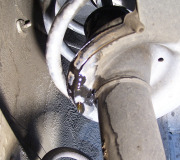Okay, I attached a flow chart that you need to follow to determine the failure.
Codes rarely identify failed parts, just failed systems.
Let me know what you find.
Roy
CIRCUIT DESCRIPTION
The Powertrain Control Module (PCM) monitors the Torque Converter Clutch (TCC) slip speed. The PCM calculates the difference between the engine speed and the transmission output speed. In D3 drive range with the TCC engaged. The engine speed should closely match the transmission output speed. When the PCM detects excessive slip of the TCC, the forward clutch, and the direct clutch when the TCC is engaged in 3rd gear, then DTC P1870 sets. DTC P1870 is a type B DTC.
CONDITIONS FOR SETTING THE DTC
No Throttle Position (TP) sensor DTCs P0122 or P0123.
No Vehicle Speed Sensor Assembly (VSS Assy.) DTCs P0502 or P0503.
The engine speed is 1,500-4,000 RPM.
MAP is 30-105 kPa.
The throttle angle is 10-50%.
The transmission is in D3 range.
The Torque Converter Clutch (TCC) is On for 5 seconds.
The TCC slip speed is greater than 148-1,000 RPM.
The vehicle speed is 56-132 km/h (35-82 mph).
The speed ratio is 0.95-1.34.
All of the above conditions are met for 7 seconds for 2 TCC engagements.
ACTION TAKEN WHEN THE DTC SETS
The PCM illuminates the Malfunction indicator Lamp (MIL).
The PCM inhibits TCC engagement.
DTC P1870 will be stored in PCM history.
CONDITIONS FOR CLEARING THE MIL/DTC
The PCM turns OFF the MIL after three consecutive trips without a failure reported.
A scan tool can clear the DTC from the PCM history. The PCM clears the DTC from the PCM history if the vehicle completes 40 warm-up cycles without a failure reported.
The PCM cancels the DTC default actions when the fault no longer exists and the ignition is OFF long enough in order to power down the PCM.
DIAGNOSTIC AIDS
Inspect the wiring at the PCM, the Automatic Transmission 4-way connector and all other circuit connecting points for the following conditions:
A bent terminal
A backed out terminal
A damaged terminal
Poor terminal tension
A chafed wire
A broken wire inside the insulation
Moisture intrusion
Corrosion
Verify that the final drive ratio is correct for the vehicle.
Check for overloading or trailer towing in excess of vehicle capacity.
TEST DESCRIPTION
The numbers below refer to the step numbers on the diagnostic table.
2. This step tests for excessive torque converter slip while the TCC is engaged.
6. Low fluid level may be causing the slipping.
9. Low line pressure may be causing the slipping.
Images (Click to make bigger)
Sunday, April 5th, 2020 AT 2:36 PM

















